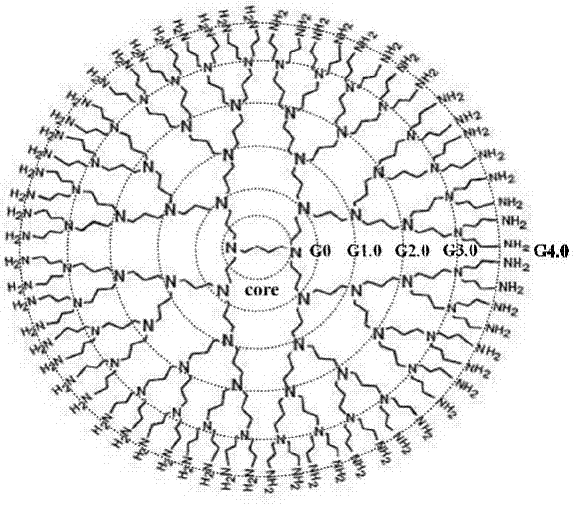Photoelectrochemical biofuel cell based on quantum dot, titanium dioxide and enzyme, and preparation method thereof
A titanium dioxide, chemical and biological technology, applied in the field of enzyme-based biofuel cells, can solve problems such as reducing the total surface area, and achieve the effects of maximizing surface area, maximizing efficiency and good dispersibility
- Summary
- Abstract
- Description
- Claims
- Application Information
AI Technical Summary
Problems solved by technology
Method used
Image
Examples
Embodiment 1
[0047] Step (1): Dissolve 20g of ethylenediamine in 100mL of methanol, stir, blow nitrogen for 15min, add 1.36mol of methyl acrylate dropwise with a constant flow pump at -30°C, react at low temperature for 48h, then raise the temperature to room temperature (20 ° C) Let it ripen for 48h. After the reaction is complete, below 45 ° C. The solvent methanol and excess methyl acrylate were distilled off under reduced pressure at 0.1 MPa to obtain 0.5G PAMAM.
[0048] Dissolve the above 25mmol of 0.5G PAMAM in 100mL of methanol, dropwise add 200mmol of ethylenediamine methanol solution with a constant flow pump, react at low temperature for 48h, and then react at room temperature for 48h. After the same reaction is complete, when it is lower than 45 ° C, distilled under reduced pressure at 0.1MPa, and added n-butanol and ethylenediamine to form an azeotropic mixture, then removed to obtain 1G PAMAM.
[0049] By repeating the above synthesis process, half-generation or whole-gen...
Embodiment 2
[0060] with "Join with Cd 2+ Equivalent amount of Se powder" to replace "adding with Cd" in step (4) 2+ Equivalent amount of Na 2 S"; and omit step (5); replace "TiO2 in step (5)" in step (6) with "P25 titanium dioxide nanoparticles" 2 fiber" repeating the steps in Example 1, and finally the anode modification is carbon paper loaded with quantum dot CdSe / P25 titanium dioxide / enzyme complex, using glucose as fuel, the measured short-circuit current of the battery reaches 450 μA / cm 2 , the open circuit voltage is 0.5 V.
PUM
| Property | Measurement | Unit |
|---|---|---|
| particle diameter | aaaaa | aaaaa |
| short-circuit current | aaaaa | aaaaa |
| particle diameter | aaaaa | aaaaa |
Abstract
Description
Claims
Application Information
 Login to View More
Login to View More - R&D
- Intellectual Property
- Life Sciences
- Materials
- Tech Scout
- Unparalleled Data Quality
- Higher Quality Content
- 60% Fewer Hallucinations
Browse by: Latest US Patents, China's latest patents, Technical Efficacy Thesaurus, Application Domain, Technology Topic, Popular Technical Reports.
© 2025 PatSnap. All rights reserved.Legal|Privacy policy|Modern Slavery Act Transparency Statement|Sitemap|About US| Contact US: help@patsnap.com

